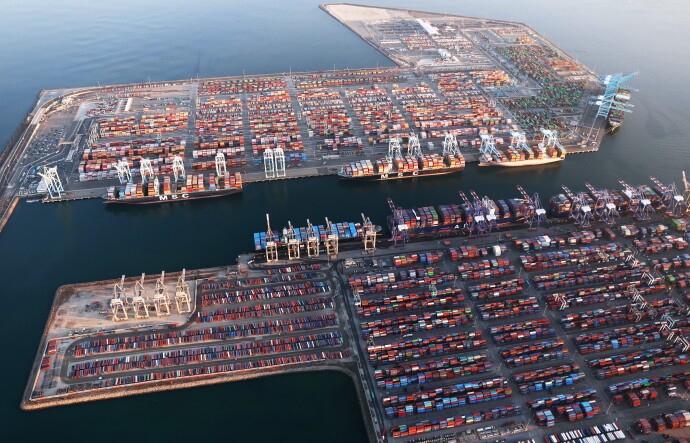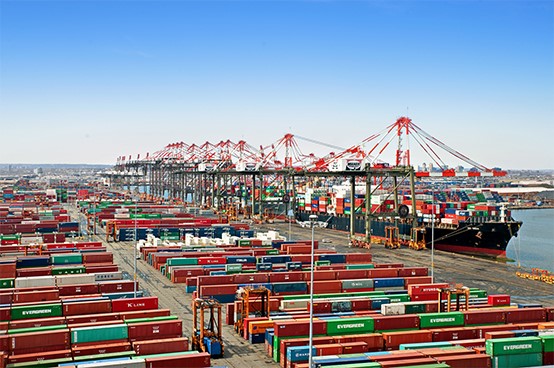A trade lane (or trade route) refers to a specific pathway along which goods are transported between two or more locations, typically across international borders. Trade lanes are established based on the flow of goods and the economic relationships between countries or regions. They encompass both maritime and air routes and play a crucial role in global supply chains by facilitating the movement of goods and fostering international trade.
Transit time refers to the duration it takes for goods or shipments to travel from their origin to their destination. It is a crucial metric in supply chain and logistics management, as it directly impacts delivery schedules, inventory levels, and customer satisfaction. Transit time encompasses the entire journey of a shipment, including transportation, handling, and processing at various checkpoints along the route.
Transloading refers to the process of transferring goods or cargo from one mode of transportation to another, typically from one type of truck or railcar to another, or from rail to truck and vice versa. This logistical practice is often employed to optimize transportation routes, reduce costs, and improve overall efficiency in supply chain operations.
A Transportation Management System (TMS) is a specialized software solution designed to streamline and optimize transportation and logistics operations within supply chains. It provides functionalities to effectively manage and control the movement of goods from origin to destination.
Transportation lead time refers to the duration it takes for goods to be transported from the point of origin to the final destination. It encompasses the time required for transportation activities, including loading, transit, and unloading, across various modes of transport such as road, rail, air, or sea.
A transshipment is the process of transferring goods from one transportation vehicle or vessel to another during their journey from origin to destination. It typically occurs at intermediary points along the supply chain route, where cargo is transferred between different modes of transportation, carriers or vessels.
Twenty-foot Equivalent Unit (TEU) is a standard unit of measurement used in the shipping industry to quantify the cargo-carrying capacity of container vessels. It represents the volume of a standard twenty-foot-long shipping container.
An Ultra Large Container Vessel (ULCV) is a massive container ship used on major trade routes, capable of carrying over 14,000 TEUs.
Vendor Managed Inventory (VMI) is a supply chain management strategy where the supplier or vendor takes responsibility for managing the inventory levels of their products at the customer's or retailer's location. In this arrangement, the vendor monitors the inventory levels based on agreed-upon criteria such as sales data or inventory levels, and initiates replenishment as needed.
Verified Gross Mass (VGM) is a term used in the shipping industry to refer to the total weight of a packed container, including its contents and packaging materials. It is a crucial requirement mandated by the International Maritime Organization (IMO) under the Safety of Life at Sea (SOLAS) convention to enhance safety in maritime transportation.
A floating structure with its own mode of propulsion designed for the transport of cargo and/or passengers. In the Industry Blueprint 1.0 "Vessel" is used synonymously with "Container vessel", hence a vessel with the primary function of transporting containers.
A vessel sharing agreement (VSA) is a cooperative arrangement between shipping companies that allows them to share space and resources on vessels for specific routes.
Vessel bunching refers to the situation where multiple vessels arrive at a port simultaneously or within a short period, leading to congestion and delays. This clustering of vessels can overwhelm port facilities, causing extended wait times for berthing, loading, and unloading operations.
A vessel call sign is a unique identifier assigned to a ship for radio communication purposes. It is used to distinguish the vessel from others in maritime communication systems, including VHF radios and satellite communications.
A vessel omission (sometimes called a port omission) occurs when a scheduled vessel does not call at a planned port during its voyage. This disruption means that the vessel skips the port entirely, which can impact the transportation and delivery schedules of goods.
In cargo shipping, vessel rotation is the planned sequence of port calls that a shipping vessel follows on its route to optimize cargo loading and unloading operations.
The timetable of departure and arrival times for each port call on the rotation of the vessel in question.
A journey by sea from one port or country to another one or, in case of a round trip, to the same port.
Warehouse utilization is a logistics metric that refers to the effective use of available warehouse space for storing goods and inventory.
Order for specific transportation work carried out by a third party provider on behalf of the issuing party.
Logistics yard management refers to the process of overseeing and controlling the movement of trucks, trailers, containers, and other vehicles within a yard or distribution center. This includes tasks such as scheduling, tracking, and coordinating the arrival, departure, and storage of these vehicles.

How Long Does It Take to Ship Cargo from Mundra to Savannah?
Shipping cargo from Mundra to Savannah takes 39.0 days on average¹. Analysis of 695 shipments shows this average includes two distinct routing methods: direct routing averaging 36.8 days and transshipment routing averaging 45.3 days¹.
The route shows performance concentrated around 34-38 days for most shipments (47.1%)¹. Understanding these patterns and the routing methods behind them helps with realistic delivery planning.

Direct vs Transshipment Routing Differences
Transit times vary significantly based on routing method. Direct routing sails point-to-point from Mundra to Savannah, accounting for 74% of shipments and averaging 36.8 days¹. Transshipment routing moves cargo through intermediate hub ports, representing 26% of volume and averaging 45.3 days¹.
Direct routing shows consistent performance with most shipments (58.3%) arriving in 32-38 days, with the largest cluster (20.0% of direct shipments) in the 34-36 day window¹. Transshipment routing spreads across wider time ranges, with clusters at 42-44 days (12.2%), 40-42 days (11.0%), and 52-54 days (11.0%)¹.
The routing choice reflects operational strategy: direct routing prioritizes speed and schedule reliability with lower variability (standard deviation of 4.7 days), while transshipment routing optimizes cost through hub consolidation but requires longer, more variable transit times (standard deviation of 8.5 days).

Carrier Performance and Routing Types
Different carriers show consistent performance patterns based on their routing strategies. MSC dominates the route with 275 shipments (39.6% of volume), followed by Hapag-Lloyd with 259 shipments (37.3%), and ONE with 96 shipments (13.8%)¹.
Direct routing performance varies by carrier. ONE achieves the fastest direct routing at 35.8 days across 57 shipments, closely followed by MSC at 35.9 days across 197 shipments¹. Hapag-Lloyd provides direct routing averaging 37.3 days over 225 shipments, while Maersk averages 39.0 days with 21 direct shipments¹.
Transshipment routing performance shows different carrier strengths. MSC operates the most efficient transshipment routing at 42.3 days across 78 shipments¹. ONE, Hapag-Lloyd, and OOCL offer transshipment services averaging 47.0-47.5 days, while Maersk's transshipment routing averages 48.5 days across 23 shipments¹.
Carrier routing strategies differ significantly. Hapag-Lloyd operates predominantly direct routing (86.9% of their volume), while Maersk splits nearly evenly between direct (47.7%) and transshipment (52.3%) services¹. MSC and ONE offer balanced portfolios with both routing options at competitive transit times.
Distribution of Transit Times
The route demonstrates a concentrated distribution pattern directly related to routing methods. Direct routing creates the primary performance cluster at 32-38 days (58.3% of direct shipments), while transshipment routing explains the longer transit times ranging from 40-55 days.
The 39.0-day average sits between these routing methods due to the volume split (74% direct, 26% transshipment) and the natural spread in each category. The median of 37.4 days¹ reflects the dominance of direct routing on this route.
Seasonal Patterns by Routing Method
Analysis of direct versus transshipment routing reveals distinct seasonal patterns based on actual shipment data from October 2024 through September 2025.
Direct routing seasonality: Direct routing maintains relatively consistent performance throughout the year, with a modest 1.5-day variance between seasons¹. Summer months (May-September) achieve the strongest performance at 36.2 days average, while winter months (November-March) extend to 37.7 days¹. June demonstrates optimal performance at 34.7 days, while March shows the longest direct routing times at 38.4 days¹.
Transshipment routing seasonality: Transshipment routing demonstrates significantly greater seasonal variation with a 6.2-day difference between seasons¹. Winter months (November-March) extend transshipment times to 50.0 days on average as major transshipment hubs face capacity constraints¹. Summer months (May-September) see improved transshipment performance at 43.8 days as hub operations run more efficiently¹. March shows peak transshipment times at 52.3 days, while June achieves optimal performance at 42.1 days¹.
This seasonal difference helps explain routing selection patterns. The smaller seasonal impact on direct routing (1.5 days) versus transshipment (6.2 days) makes direct routing particularly attractive during winter months when shippers prioritize schedule predictability. Summer months narrow the performance gap, making transshipment routing more competitive for cost-sensitive cargo.
Planning Considerations by Routing Type
Direct routing planning: Use 35-40 day windows for direct routing. Most direct shipments (58%) arrive within the 32-38 day range. Direct routing shows more consistent performance with predictable arrival patterns and lower variability (standard deviation of 4.7 days). Carrier selection affects planning: ONE and MSC achieve fastest direct performance at 35.8-35.9 days, while Hapag-Lloyd averages 37.3 days. Summer months offer the fastest performance (36.2 days average), while winter adds approximately 1.5 days.
Transshipment planning: Allow 43-50 days for transshipment routing during summer months and 48-55 days during winter months. Performance varies based on hub efficiency and connection timing. MSC provides the fastest transshipment routing at 42.3 days, while other carriers average 47-48.5 days. Consider additional buffers for operational variations at intermediate ports, as transshipment shows higher variability (standard deviation of 8.5 days). Seasonal differences of 6.2 days between summer and winter require adjusted planning windows.
Routing selection: Direct routing typically commands higher pricing but provides schedule reliability across all seasons. Transshipment routing offers cost savings through consolidation but requires longer planning windows and seasonal-specific buffer time, particularly during winter months when hub congestion increases transit times by approximately 6 days.
Data Sources: ¹ Analysis based on Beacon platform data: 695 shipments (October 2024 - September 2025) showing 514 direct services (36.8-day average) and 181 transshipment services (45.3-day average),




